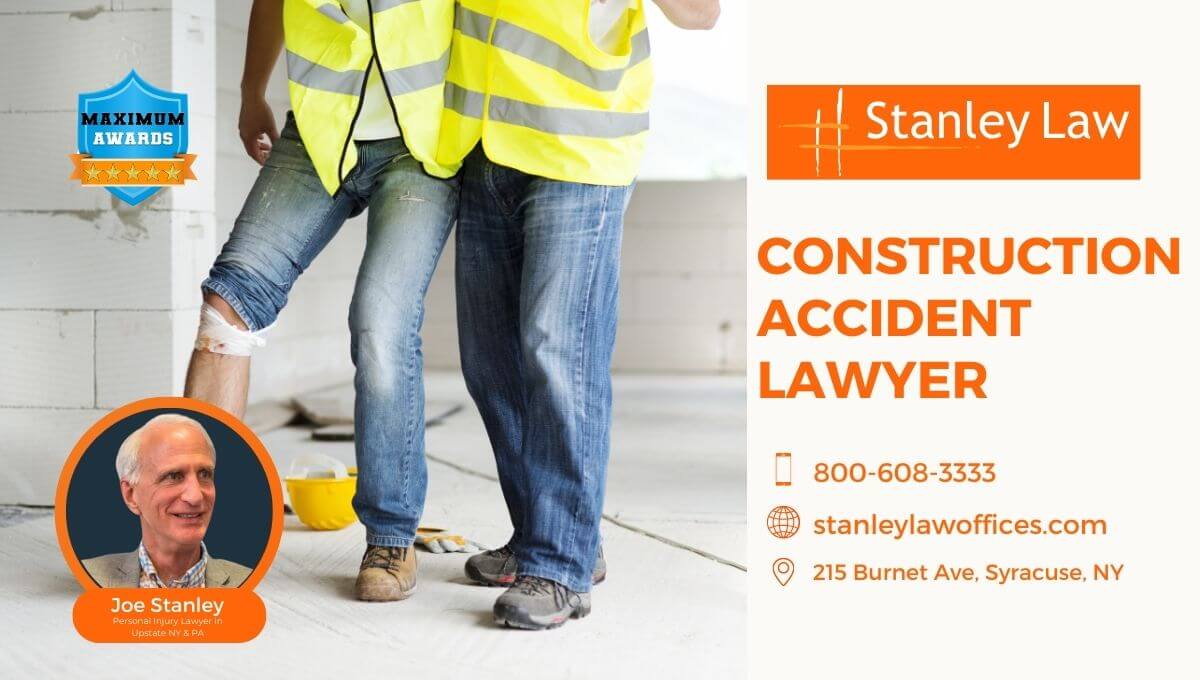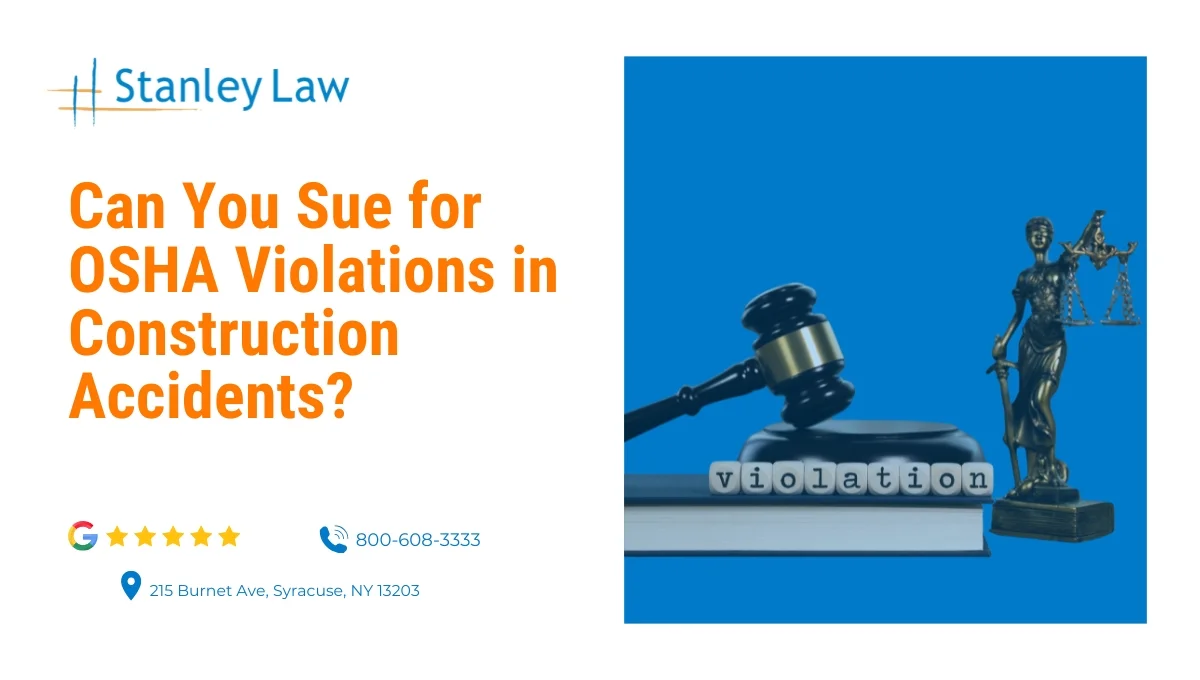Have you or a loved one been injured or faced unsafe conditions on a construction site? You might be wondering, “Can you sue for OSHA violations?” The answer is yes—while you can’t sue OSHA directly, you can pursue legal action against your employer through personal injury or workers’ compensation claims. OSHA’s job is to set standards that keep workplaces safe, but violations can still happen. Knowing your legal options and the steps you can take to seek justice is crucial when they do.
In this blog, we’ll break down your rights, guide you through the legal process, and explain how to hold your employer accountable if OSHA violations caused your injury.
If you’ve experienced unsafe working conditions, you don’t have to face this alone—learn how to protect your rights and take action.
Understanding OSHA and Its Regulatory Impact
The Occupational Safety and Health Administration (OSHA) is critical in maintaining workplace safety across various industries. Established under the Occupational Safety and Health Act of 1970, OSHA sets and enforces safety standards to protect workers from dangerous conditions.
OSHA’s primary goal is to reduce workplace hazards and ensure that employers provide safe environments. Whether it’s construction, manufacturing, healthcare, or retail, OSHA regulations are there to minimize risks and prevent accidents. But what happens when these standards are violated?
Let’s explore OSHA’s specific regulations for construction sites.
OSHA Regulations for Construction Sites
Construction sites are inherently dangerous, so OSHA has strict regulations to ensure worker safety. Some key OSHA regulations for construction include:
- Fall Protection (29 CFR 1926.501): Employers must provide fall protection systems, such as guardrails, safety nets, or personal fall arrest systems, for workers at risk of falling.
- Scaffolding (29 CFR 1926.451): Specifies scaffold design, construction, and use safety requirements.
- Hazard Communication (29 CFR 1926.59): Employers must inform workers about hazardous chemicals through labels, safety data sheets, and training.
- Personal Protective Equipment (PPE) (29 CFR 1926.28): Employers must provide appropriate PPE, such as hard hats, gloves, and eye protection.
- Excavations (29 CFR 1926.650-652): Establishes safety standards for excavation activities, including protective systems to prevent trench collapses.
- Electrical Safety (29 CFR 1926.400-449): Sets standards for electrical installations and maintenance to prevent hazards.
- Machinery and Tools (29 CFR 1926.300): Provides guidelines for safely using machinery and tools.
- Noise (29 CFR 1926.52): Limits noise levels and mandates hearing protection to prevent hearing loss.
- Cranes and Derricks (29 CFR 1926.1400-1442): Regulates crane and derrick use, including operator certification and safety protocols.
Non-compliance can lead to severe penalties, fines, and legal repercussions.
The Broader Scope of OSHA Violations
OSHA regulations aren’t just for construction sites. They cover many industries, from manufacturing to healthcare, each with guidelines based on the unique risks involved. Whether it’s ensuring proper hazard communication in factories or providing PPE in healthcare settings, OSHA’s reach is broad, protecting workers in various fields.
Proactive Strategies to Prevent OSHA Violations
Prevention is key when it comes to avoiding OSHA violations. Employers must take a proactive approach to workplace safety, and here’s how they can do it:
- Safety Management Systems: Develop comprehensive safety plans that identify and address potential hazards.
- Routine Inspections: Conduct regular inspections to help employers catch safety issues before they become violations.
- Employee Training Programs: Train employees continuously. Ensure safety awareness and equipment proficiency.
While these strategies can help, knowing your legal options is important if violations occur.

Legal Grounds and Rights for Suing Over OSHA Violations
OSHA gives workers specific rights to protect themselves and take action when employers fail to meet safety standards.
Worker Rights Under OSHA
Under OSHA, workers have critical rights, including:
- Right to a Safe Workplace: Employers must eliminate known hazards.
- Right to Training: Ensure workers undergo training to understand safety and hazards.
- Right to Access Records: Employees can review workplace injury records.
- Right to Request Inspections: Workers can request an OSHA inspection without fear of retaliation.
- Right to Report Injuries: Workers can report injuries or violations without being fired or punished by their employer.
These rights enable workers to hold employers accountable and seek necessary legal action.
Why Knowing Your Rights Matters
Knowing your rights under OSHA helps you take action against unsafe working conditions. It can also strengthen your legal claim if you file a personal injury or workers’ compensation lawsuit. Don’t let fear of retaliation stop you—your rights are protected, and taking action can help ensure a safer workplace for others.
Have you experienced an OSHA violation? Contact us today for a free consultation to discuss your legal options.
Identifying and Documenting OSHA Violations
Proper documentation is key to building a strong case if you believe your employer has violated OSHA regulations.
Common OSHA Violations in Construction
Some of the most common OSHA violations seen on construction sites include:
- Fall Hazards: Lack of proper fall protection.
- Unsafe Scaffolding: Scaffolds that don’t meet safety standards.
- Inadequate PPE: Absence of essential gear like helmets or gloves.
- Improper Hazard Communication: Failing to label or train workers on hazardous materials.
- Electrical Hazards: Unprotected live wires.
- Trenching Hazards: Unsafe trenches without protective systems.
Documenting and Preserving Evidence of Violations
Proper documentation of OSHA violations can greatly strengthen a legal claim. Here are ways to effectively document and preserve evidence:
- Photos of the unsafe conditions
- Witness Statements from coworkers
- Injury Reports filed with your employer
- Inspection Records showing previous safety issues
- Details on the time and location of the violation.
Collecting this evidence strengthens your case. Contact our legal team for expert guidance if you need assistance gathering and preserving documentation.

The Legal Process for Addressing OSHA Violations
Two primary ways to address OSHA violations are filing a complaint or pursuing a lawsuit.
Complaints vs. Lawsuits
Filing a Complaint with OSHA: Reporting violations to OSHA can help improve safety without seeking compensation.
- Filing a Lawsuit: If the violation resulted in an injury, you can pursue legal action through a personal injury or workers’ compensation claim to recover damages.
- Each option has benefits: a complaint may resolve the safety issue faster, but a lawsuit can compensate for your injuries.
Criteria for a Successful Lawsuit
To succeed in a lawsuit related to OSHA violations, you’ll need:
- Proof of Negligence: The employer must have violated safety standards, which caused your injury.
- Clear Evidence: Photos, witness statements, and medical records are essential.
- Injury or Damage: You must demonstrate that the violation directly caused harm.
- Legal Standard: Depending on your case type, your claim must meet legal standards for personal injury or workers’ compensation.
If you’re unsure which option to choose, contact us for help determining the best legal approach.
Steps to Take if Suing for OSHA Violations
If you’re considering legal action, follow these steps to strengthen your case.
Report to OSHA
First, report the violation to OSHA. Be sure to include specific details about the unsafe conditions, as this can help support your claim.
Seek Medical Attention
If you are injured, seeking medical care is essential. Your medical records will serve as critical evidence in your case.
Consult with a Construction Accident Lawyer
It’s important to consult with an experienced construction accident lawyer. They will evaluate your case, gather evidence, and guide you through the legal process.
Gather Witness Statements
Witnesses can make or break your case. Collect statements from coworkers who witnessed the violation or unsafe conditions.
Follow Through with the Legal Process
Once your lawyer files the lawsuit, expect a series of steps such as evidence gathering, negotiations, and possibly a trial. We’ll be with you every step of the way to ensure proper handling of your case.
Contact our firm today for expert legal support in your OSHA violation case.
Potential Outcomes of an OSHA Violation Lawsuit
When suing for an OSHA violation, you may be entitled to several types of damages:
Types of Recoverable Damages
- Economic Damages: Cover medical expenses, lost wages, and future medical care.
- Non-Economic Damages: Include compensation for pain and suffering, emotional distress, and reduced quality of life.
- Punitive Damages: In cases of severe negligence, the court may award punitive damages to punish the employer and prevent future violations.
How Stanley Law Office Can Help
We have extensive experience handling OSHA violation cases at Stanley Law Office, especially construction-related accidents. Here’s how we can help:
- Case Evaluation: We’ll determine the best legal strategy for your case.
- Evidence Gathering: Our team will help collect and preserve crucial evidence.
- Expert Representation: We’ll advocate to ensure your rights are protected.
Don’t face OSHA violations alone—contact us today to discuss how we can assist you.

Conclusion
Recognizing and acting on OSHA violations is crucial for protecting your safety and rights in the workplace. Unsafe working conditions can lead to serious injuries and legal consequences, so don’t wait to take action.
If you’ve been affected by an OSHA violation, it’s time to explore your legal options. Our experienced team at Stanley Law Office is here to help you deal with the legal process and secure the compensation you deserve.
Contact us now at 1-800-608-3333 for a free consultation, and let us help you pursue justice.
Can You Sue For Osha Violation – FAQs
How Does OSHA Define an Accident?
OSHA defines an accident as any unexpected event that results in injury or illness. It includes incidents that occur due to unsafe working conditions or negligence.
What Should I Do If My Employer Ignores OSHA Regulations?
If your employer ignores OSHA regulations:
- Report the Violation: File a complaint with OSHA, providing specific details.
- Document the Issue: Take photos, collect witness statements, and gather evidence.
- Seek Medical Attention: If you’re injured, see a doctor immediately.
Can I Be Fired for Reporting OSHA Violations?
No, it is illegal for an employer to fire or retaliate against an employee for reporting OSHA violations.
Can I Sue My Employer if OSHA Fines Them?
While you can’t sue just because OSHA fines your employer, you can file a personal injury or workers’ compensation lawsuit if the violation caused you harm.
How Long Do I File a Lawsuit After an OSHA Violation?
In most states, you have three years from the date of the injury or when you became aware of it to file a lawsuit. However, this varies by state, so it’s important to consult with an attorney to ensure you meet the deadline.

